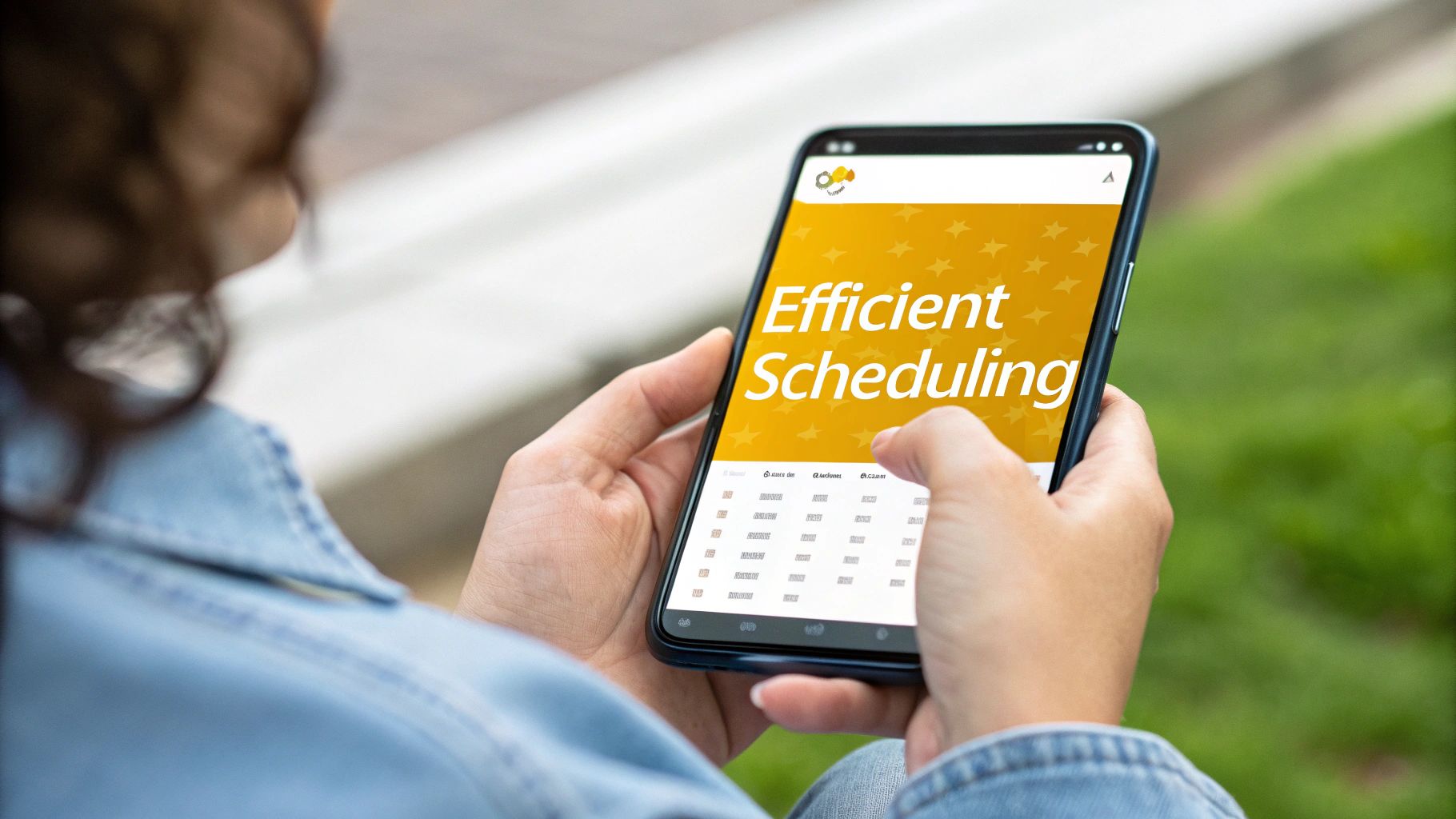From our resource library for organizational scheduling and management.
Best App for Scheduling Shifts: How To Transform Your Workforce Management

Why Traditional Scheduling Methods Are Holding You Back

Managing employee schedules with spreadsheets and whiteboards creates real problems for businesses. These basic tools lead to mistakes, waste time, and leave both managers and staff feeling frustrated. Every hour spent fixing scheduling errors is time that could be spent on growing the business.
Think about trying to handle shift swaps and time-off requests using paper schedules posted on a wall. When last-minute changes come up, managers have to manually update everything and somehow notify all affected employees. This clunky process makes it nearly impossible to respond quickly to changing needs. Staff members end up stuck with inflexible schedules that hurt their work-life balance.
The Hidden Costs of Outdated Scheduling
Poor scheduling causes more damage than just daily hassles - it directly impacts the bottom line. When managers accidentally overstaff or understaff shifts, labor costs spike while service quality drops. But the biggest toll often comes from how outdated scheduling affects employees themselves.
Staff burnout is a serious issue that stems from rigid, poorly managed schedules. The constant stress of trying to arrange shift coverage and handle schedule changes wears people down. Research shows that 55% of employees will quit if they don't have enough control over their work hours. For more eye-opening statistics, check out this analysis of employee shift scheduling software. The data is clear - giving staff more scheduling flexibility through modern tools can reduce turnover risk by 174%. You can learn more about this in our guide to mastering modern workforce management.
Embracing the Power of Scheduling Apps
Smart businesses are moving away from manual scheduling by adopting apps for scheduling shifts. These tools handle the tedious work automatically, freeing up managers to focus on bigger priorities. Staff members gain the ability to easily request time off, swap shifts, and manage their schedules through a simple app. With everything managed in one central system, both managers and employees can communicate clearly about scheduling needs. Making the switch to digital scheduling creates lasting improvements in efficiency and job satisfaction.
Essential Features That Drive Real Results

Good scheduling software does much more than just assign shifts. The best solutions offer powerful tools that make managing your workforce easier and more effective. When evaluating scheduling apps, it's important to look beyond basic functions to find features that will actually improve your operations and keep your team happy.
Must-Have Features for Modern Scheduling
The foundation of any good scheduling app starts with solving common workplace challenges. Here are the key features that make a real difference:
Automated Scheduling: Save hours of manual work by letting the system create optimized schedules based on your rules, staff availability, and needed skills. Managers can focus on more important tasks instead of juggling spreadsheets.
Real-Time Communication: Keep everyone in the loop instantly about shift swaps, openings, and updates. Clear communication prevents confusion and scheduling headaches.
Employee Self-Service: Give staff control over their own schedules - from requesting time off to trading shifts with coworkers. This independence boosts morale and reduces manager workload.
Mobile Access: Your team needs schedule info on the go. A good mobile app lets employees check schedules, claim shifts, and communicate from anywhere.
Advanced Features for Optimized Performance
Beyond the basics, these additional tools can take your scheduling to the next level:
Predictive Scheduling: Use past data to forecast staffing needs and optimize coverage. This helps avoid expensive overstaffing while ensuring you have enough people when busy.
Integrated Time Tracking: Connect schedules directly to time cards and payroll for accurate labor costs and easier processing.
Reports and Analytics: Make better decisions with clear data about scheduling patterns, labor costs, and team performance over time.
Modern scheduling software makes the entire process smoother through automation. For example, Connecteam offers auto-scheduling that creates optimized schedules in minutes instead of hours of manual work.
Evaluating Your Needs
The features you need depend on your specific situation. A small shop might just need basic mobile scheduling and shift swapping. A large hospital requires more complex tools like predictive scheduling and detailed reporting. Start by listing your main scheduling challenges and must-have features. This will help you find the right solution that addresses your actual needs without paying for unnecessary extras.
Empowering Your Workforce Through Mobile Access

Work scheduling has fundamentally changed with the rise of mobile technology. Staff members no longer need to check physical schedules or log into office computers - they can access everything they need right from their phones. This simple but powerful change has reshaped how teams coordinate their work hours and maintain work-life balance.
Putting the Power of Scheduling in Employees' Hands
Modern scheduling apps give workers direct control over their time. From checking upcoming shifts to requesting days off, employees can handle schedule changes wherever they are. For instance, if a server needs to find coverage for an evening shift, they can quickly message coworkers through the app and get approval from their manager - all in a few taps.
This independence makes a real difference in job satisfaction. When staff can easily manage their own schedules, they feel more in control of their work lives. Teams also communicate better since everyone stays updated on schedule changes through instant notifications.
The impact goes beyond convenience. Clear communication through these apps builds stronger teams, as everyone shares responsibility for keeping shifts covered. When workers can quickly help each other with schedule swaps, it creates a more supportive workplace culture.
The Benefits of Mobile-First Scheduling for Businesses
Companies see major advantages from mobile scheduling too. One key improvement is fewer missed shifts - when employees can easily check their schedules anytime, they're less likely to forget when they work. Recent studies show that mobile scheduling can reduce no-shows by up to 30%.
The administrative benefits are significant as well. Managers spend less time on paperwork since staff handle many scheduling tasks themselves through the app. This frees up leadership to focus on other priorities like training and customer service.
Mobile access has become essential for any modern scheduling system. Apps like Connecteam let workers set their availability and request time off right from their phones. For more options, check out this guide to best restaurant scheduling software. Making schedules mobile-friendly helps businesses run more smoothly while giving employees the flexibility they value. The result is better-organized teams and happier workers who stay with the company longer.
Building Your Implementation Roadmap

Moving to a new scheduling system takes careful preparation and planning. Making the switch affects everyone in your organization, so you'll want to follow a clear roadmap that gets your team on board while keeping daily operations running smoothly.
Phase 1: Planning and Preparation
Start by getting crystal clear about what you want to achieve. Are you trying to reduce missed shifts? Improve how your team communicates? Cut down on scheduling headaches? Write down your specific goals and challenges.
Take a close look at how scheduling works right now in your organization. What parts of the process frustrate your team? Where do things break down? Talk to managers and staff to understand their daily struggles with the current system. Their input will help you pick an app that actually solves real problems.
Phase 2: App Selection and Data Migration
With your needs mapped out, you can evaluate different scheduling apps. Focus on must-have features, how easy the app is to use, and whether it works with your other business tools. For example, Acroroster connects directly with your existing databases and provides support for large organizations.
Getting your current schedules and employee information into the new system needs special attention. Double-check that you can transfer all your important data without losing anything. This extra care up front prevents headaches later during the rollout.
Phase 3: Training and Communication
The best app won't help if people don't know how to use it. Set aside time for thorough training through a mix of online guides, in-person sessions, and ongoing help resources. Make sure everyone feels comfortable with the basic features they'll use daily.
Keep your team in the loop throughout the whole process. Be upfront about how the new app will change their regular routines. Listen to their concerns and address them directly. When people understand the "why" behind the change, they're more likely to embrace it.
Phase 4: Go-Live and Optimization
Start small when you launch. Pick one department or team to try the app first. This lets you spot and fix any issues before rolling it out to everyone else.
Watch how things go after launch. Keep track of important numbers like:
- How many people are actually using the app
- Whether schedules are being made faster
- What your team thinks about the new system
Ask for honest feedback and make adjustments based on what you learn. The more you fine-tune things based on real use, the more value you'll get from your investment. Success comes down to good communication, proper training, and a willingness to adapt based on your team's experience.
Maximizing ROI Through Advanced Analytics
Smart scheduling software goes beyond basic shift planning. The real value comes from advanced analytics that turn everyday scheduling data into practical business insights that boost your bottom line. Smart companies use features like predictive scheduling, labor cost analysis, and performance tracking to improve operations and grow their business.
Predictive Scheduling: Optimizing Staffing Levels
Getting staff levels right is crucial for business success. Rather than guessing, predictive scheduling uses past data to accurately forecast when you'll need more or fewer workers. For instance, a coffee shop can look at last year's sales during different seasons, along with local events and weather patterns, to schedule just the right number of baristas. This means you're not overpaying for idle staff during slow times while ensuring great service during rush hours.
Labor Cost Analysis: Understanding Where Your Money Goes
Keeping track of labor spending is key to running a profitable business. Good scheduling software breaks down costs by team, position, and individual employee. This detailed view helps you spot where labor costs are too high and fix issues quickly. By connecting time tracking directly with scheduling, you create a simple system that handles everything from shift planning to paychecks without manual data entry mistakes.
Performance Tracking: Measuring and Improving Efficiency
Good analytics reveal how well your team is performing. By tracking things like attendance, on-time arrival, and completed shifts, you get clear insights into both individual and team success. This information helps identify your best workers, spot who needs extra training, and solve problems early. For example, if someone is often late, you might need to adjust their schedule or check if there are transportation issues. For more insights on effective staff management, check out The Ultimate Guide to Staff Roster Programs.
Data-Driven Decisions for a Thriving Business
When you combine smart scheduling, cost tracking, and performance metrics, you can make better choices about your workforce. As the system collects more data over time, its predictions get more accurate, leading to better schedules and lower costs. This ongoing improvement helps create both a more profitable business and happier employees.
Choosing scheduling software with strong analytics is a smart move for any business. It gives managers the tools they need to make informed decisions, use resources wisely, and create a better work environment for everyone.
The Future of Intelligent Scheduling
The way businesses handle staff scheduling is undergoing major changes. AI, machine learning, and predictive analytics tools have replaced basic spreadsheets and manual scheduling, making workforce management more efficient and employee-focused than ever before.
AI-Powered Optimization: Moving Beyond Guesswork
Modern scheduling software does much more than just manage time-off requests. These smart systems analyze data from multiple sources - like sales records, staffing patterns, and even weather forecasts - to make scheduling decisions based on real evidence rather than gut feel. When a retail store uses AI scheduling, for instance, it can look at previous sales data to ensure enough staff are scheduled during historically busy shopping periods.
Machine Learning: Adapting to the Unexpected
While AI excels at making predictions from existing data, machine learning goes further by continuously improving its accuracy over time. As new situations arise, the system learns and adjusts its recommendations automatically. This is especially valuable in fast-paced environments like hospitals, where patient volumes can change quickly and unexpectedly. For more details on healthcare scheduling, check out our guide to nurse rostering software.
Predictive Analytics: Forecasting Future Needs
Think of predictive analytics like a weather forecast for your workforce needs. By analyzing past patterns, these tools can spot potential staffing gaps weeks in advance, giving managers time to address them before they become problems. This forward-looking approach helps businesses avoid last-minute schedule changes and reduce unnecessary overtime costs.
Preparing for the Next Generation of Scheduling
As scheduling technology continues to improve, businesses need to stay ready for new developments. Here's what that means:
- Staying informed: Keep up with new scheduling tools and features as they emerge
- Prioritizing needs: Choose scheduling tools that solve your specific challenges
- Embracing flexibility: Select software that can grow with your business
The Future is Intelligent
Smart scheduling tools powered by AI, machine learning, and predictive analytics are changing how businesses manage their workforce. These advances help companies move from reactive to proactive scheduling, leading to better efficiency and happier employees. Acroroster offers a complete platform built to handle modern scheduling needs. Learn more about how Acroroster can help you transform your scheduling processes.